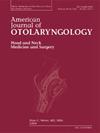舌下免疫治疗屋尘螨致变应性咽炎合并鼻炎的临床疗效及安全性评价
IF 1.7
4区 医学
Q2 OTORHINOLARYNGOLOGY
引用次数: 0
摘要
舌下免疫治疗(SLIT)已被广泛认为是过敏性气道疾病的一种疾病改善治疗方法。然而,其在过敏性咽炎(AP)中的有效性和安全性仍未得到充分的研究,需要进一步的临床验证。方法回顾性研究100例屋尘螨(HDM)诱发AP合并变应性鼻炎(AR)患者。所有参与者连续三年接受标准化的SLIT治疗。临床结果,包括总咽部症状评分(TPLSS)、总鼻症状评分(TNSS)、总用药评分(TMS)、视觉模拟量表(VAS)评分和生活质量测量,在基线和治疗开始后3个月、6个月、1年、2年和3年进行系统评估。通过不良事件(ae)评估安全性。结果与基线相比,AP合并AR患者在随访期间咽部和鼻部症状均有显著改善,有症状的药物使用减少,生活质量提高。亚组比较显示单致敏和多致敏患者的疗效无显著差异。此外,鼻部和咽部症状呈正相关(R2 = 0.44, P < 0.001)。主要不良反应主要发生在前三个月内,未见严重不良反应报告。结论HDM-SLIT治疗3年可同时缓解AP和AR患者的咽鼻症状,从而扩大了SLIT在气道变应性疾病治疗中的应用。本文章由计算机程序翻译,如有差异,请以英文原文为准。
Assessment of clinical efficacy and safety of sublingual immunotherapy for house dust mite-induced allergic pharyngitis with rhinitis
Background
Sublingual immunotherapy (SLIT) has been widely established as a disease-modifying treatment for allergic airway diseases. However, its efficacy and safety in allergic pharyngitis (AP) remain insufficiently investigated and require further clinical validation.
Methods
In this retrospective study, 100 patients diagnosed with house dust mite (HDM)-induced AP concomitant with allergic rhinitis (AR) were enrolled. All participants received standardized SLIT for three consecutive years. Clinical outcomes, including total pharyngolaryngeal symptom score (TPLSS), total nasal symptom score (TNSS), total medication score (TMS), visual analog scale (VAS) scores, and quality of life measures, were systematically assessed at baseline and subsequently at 3 months, 6 months, 1 year, 2 years, and 3 years post-treatment initiation. Safety was evaluated through adverse events (AEs).
Results
Compared to the baseline, patients with AP accompanied by AR exhibited significant improvements in both pharyngeal and nasal symptoms during the follow-up, with a reduction in symptomatic medication use and an improvement in quality of life. Subgroup comparisons revealed no significant difference in efficacy between mono- and poly-sensitized patients. Furthermore, a positive correlation was observed between nasal and pharyngeal symptoms (R2 = 0.44, P < 0.001). Major AEs occurred primarily within the first three months, and no serious AEs were reported.
Conclusion
Three years of HDM-SLIT may alleviate both pharyngeal and nasal symptoms in patients with AP and AR, thereby expanding the application of SLIT in the treatment of airway allergic diseases.
求助全文
通过发布文献求助,成功后即可免费获取论文全文。
去求助
来源期刊

American Journal of Otolaryngology
医学-耳鼻喉科学
CiteScore
4.40
自引率
4.00%
发文量
378
审稿时长
41 days
期刊介绍:
Be fully informed about developments in otology, neurotology, audiology, rhinology, allergy, laryngology, speech science, bronchoesophagology, facial plastic surgery, and head and neck surgery. Featured sections include original contributions, grand rounds, current reviews, case reports and socioeconomics.
 求助内容:
求助内容: 应助结果提醒方式:
应助结果提醒方式:


